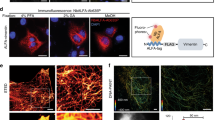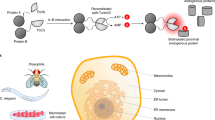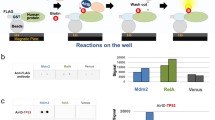Abstract
This protocol details methodologies for the site-specific biotinylation of proteins using in vitro, in vivo and cell-free systems for the purpose of fabricating functional protein arrays. Biotinylation of recombinant proteins, in vitro as well as in vivo, relies on the chemoselective reaction between cysteine-biotin and a reactive thioester group at the C-terminus of a protein generated via intein-mediated cleavage. The cell-free system utilizes low concentrations of biotin-conjugated puromycin. Unlike other approaches that require tedious and costly downstream steps of protein purification, C-terminal biotinylated proteins can be captured directly onto avidin-functionalized slides from a mixture of other cellular proteins to generate the corresponding protein array. These methods were designed to maintain the integrity and activity of proteins in a microarray format, which potentially allows simultaneous functional assays of thousands of proteins. Assuming that the target proteins have been cloned into the expression vector, transformation of bacterial strain and growth of starter culture would take ∼2 days. Expression and in vitro protein purification and biotinylation will take ∼3 days whereas the in vivo method would take ∼2 days. The cell-free protein biotinylation strategy requires only 6–8 h.
This is a preview of subscription content, access via your institution
Access options
Subscribe to this journal
Receive 12 print issues and online access
$259.00 per year
only $21.58 per issue
Buy this article
- Purchase on Springer Link
- Instant access to full article PDF
Prices may be subject to local taxes which are calculated during checkout






Similar content being viewed by others
References
Chattopadhaya, S. & Yao, S.Q. in Enzyme Assays: High Throughput Screening, Genetic Selection and Fingerprinting (ed. Reymond, J.-L.) (Wiley-VCH Verlag GmbH & Co. KGaA, Weinheim, Germany, 2006).
Vijayendran, R.A. & Leckband, D.E. A quantitative assessment of heterogeneity for surface-immobilized proteins. Anal. Chem. 73, 471–480 (2001).
LaBear, J. & Ramachandran, N. Protein microarrays as tools for functional proteomics. Curr. Opin. Chem. Biol. 9, 1–6 (2005).
Zhu, H. et al. Global analysis of protein activities using proteome chips. Science 293, 2101–2105 (2001).
Hodneland, C.D., Lee, Y. -S., Min, D. -H. & Mrksich, M. Selective immobilization of proteins to self-assembled monolayers presenting active site-directed capture ligands. Proc. Natl. Acad. Sci. USA. 99, 5048–5052 (2002).
Kindermann, M., George, N., Johnsson, N. & Johnsson, K. Covalent and selective immobilization of fusion proteins. J. Am. Chem. Soc. 125, 7810–7811 (2003).
Yin, J., Liu, F., Li, X. & Walsh, C.T. Labeling proteins with small molecules by site-specific posttranslational modification. J. Am. Chem. Soc. 126, 7754–7755 (2004).
Paborsky, L.R., Dunn, K.E., Gibbs, C.S. & Dougherty, J.P. A nickel chelate microtiter plate assay for six histidine-containing proteins. Anal. Biochem. 234, 60–65 (2004).
de Araújo, A.D. et al. Diels–Alder ligation and surface immobilization of proteins. Angew. Chemie Int. Ed. 45, 296–301 (2006).
Watzke, A. et al. Site-selective protein immobilization by Staudinger ligation. Angew. Chemie Int. Ed. 45, 1408–1412 (2006).
Lin, P.-C. et al. Site-specific protein modification through CuI-catalyzed 1,2,3-triazole formation and its implementation in protein microarray fabrication. Angew. Chemie Int. Ed. 45, 4286–4290 (2006).
Dawson, P.E., Muir, T.W., Lewis, I.C. & Kent, S.B Synthesis of proteins by native chemical ligation. Science 266, 776–779 (1994).
Muir, T.W. Semisynthesis of proteins by expressed protein ligation. Annu. Rev. Biochem. 72, 249–289 (2003).
Muir, T.W., Sondhi, D. & Cole, P.A. Expressed protein ligation: a general method for protein engineering. Proc. Natl. Acad. Sci. USA. 95, 6705–6710 (1998).
Lovrinovic, M. et al. Synthesis of protein–nucleic acid conjugates by expressed protein ligation. Chem. Commun. 822–823 (2003).
Yeo, S.Y.D., Srinivasan, R., Uttamchandani, M., Chen, G.Y.J., Zhu, Q. & Yao, S.Q. Cell-permeable small molecule probes for site-specific labeling of proteins. Chem. Commun. 2870–2871 (2003).
Tolbert, T.J. & Wong, C.-H. Intein mediated synthesis of proteins containing carbohydrates and other molecular probes. J. Am. Chem. Soc. 122, 5421–5428 (2000).
Hahn, M.E. & Muir, T.W. Photocontrol of Smad2, a multiphosphorylated cell signaling protein, through caging of activated phosphoserines. Angew. Chemie Int. Ed. 43, 5800–5803 (2004).
Pellois, J.–P. & Muir, T.W. A ligation and photorelease strategy for the temporal and spatial control of protein function in living cells. Angew. Chemie Int. Ed. 44, 5713–5717 (2005).
Kwon, Y., Coleman, M.A. & Camarero, J.A. Selective immobilization of proteins onto solid supports through split-intein-mediated protein trans-splicing. Angew. Chemie Int. Ed. 45, 1726–1729 (2006).
Camarero, J.A., Kwon, Y. & Coleman, M.A. Chemoselective attachment of biologically active proteins to surfaces by expressed protein ligation and its application for “Protein Chip” fabrication. J. Am. Chem. Soc. 126, 14730–14731 (2004).
Lesaicherre, M.-L., Lue, R.Y.P., Chen, G.Y.J., Zhu, Q. & Yao, S.Q. Intein-mediated biotinylation of proteins and its application in a protein microarray. J. Am. Chem. Soc. 124, 8768–8769 (2002).
Lue, R.Y.P., Chen, G.Y.J., Hu, Y., Zhu, Q. & Yao, S.Q. Versatile protein biotinylation strategies for potential high-throughput proteomics. J. Am. Chem. Soc. 126, 1055–1062 (2004).
Cronan, J.E. & Reed, K.E. Biotinylation of proteins in vivo: a useful posttranslational modification for protein analysis. Methods Enzymol. 326, 440–458 (2000).
Tan, L.P., Lue, R.Y.P., Chen, G.Y.J. & Yao, S.Q. Improving the intein-mediated, site-specific protein biotinylation strategies both in vitro and in vivo. Bioorg. Med. Chem. Lett. 14, 6067–6070 (2004).
Miyamoto-Sato, E., Nemoto, N., Kobayashi, K. & Yanagawa, H. Specific bonding of puromycin to full-length protein at the C-terminus. Nucleic Acids. Res. 28, 1176–1182 (2000).
Tan, L.P., Chen, G.Y.J. & Yao, S.Q. Expanding the scope of site-specific protein biotinylation strategies using small molecules. Bioorg. Med. Chem. Lett. 14, 5735–5738 (2004).
Girish, A., Sun, H., Yeo, D.S.Y., Chen, G.Y.J., Chua, T.-K. & Yao, S.Q. Site-specific immobilization of proteins in a microarray using intein-mediated protein splicing. Bioorg. Med. Chem. Lett. 15, 2447–2451 (2005).
Tolbert, T.J. & Wong, C.-H. New methods for proteomic research: preparation of proteins with N-terminal cysteines for labeling and conjugation. Angew. Chemie Int. Ed. 41, 2171–2174 (2002).
Kapust, R.B. & Waugh, D.S. Controlled intracellular processing of fusion proteins by TEV protease. Protein Expr. Purif. 19, 312–318 (2000).
Sambrook, J., Fritsch, E.F. & Maniatis, T in Molecular Cloning: A Laboratory Manual 2nd edn. (Cold Spring Harbor Laboratory Press, New York, NY, USA, 1989).
Cronan, J.E. Biotination of proteins in vivo. J. Biol. Chem 265, 10327–10333 (1990).
Agafonov, D.E., Rabe, K.S., Grote, M., Voertler, C.S. & Sprinzl, M. C-terminal modifications of a protein by UAG-encoded incorporation of puromycin during in vitro protein synthesis in the absence of release factor 1. ChemBioChem 7, 330–336 (2006).
Author information
Authors and Affiliations
Corresponding author
Ethics declarations
Competing interests
The authors declare no competing financial interests.
Rights and permissions
About this article
Cite this article
Chattopadhaya, S., Tan, L. & Yao, S. Strategies for site-specific protein biotinylation using in vitro, in vivo and cell-free systems: toward functional protein arrays. Nat Protoc 1, 2386–2398 (2006). https://doi.org/10.1038/nprot.2006.338
Published:
Issue Date:
DOI: https://doi.org/10.1038/nprot.2006.338
This article is cited by
-
Apolipoprotein A-IV binds αIIbβ3 integrin and inhibits thrombosis
Nature Communications (2018)
-
Imaging proteins in live mammalian cells with biotin ligase and monovalent streptavidin
Nature Protocols (2008)
-
Peptide microarrays for high-throughput studies of Ser/Thr phosphatases
Nature Protocols (2008)
-
Inhibitor fingerprinting of metalloproteases using microplate and microarray platforms: an enabling technology in Catalomics
Nature Protocols (2007)
Comments
By submitting a comment you agree to abide by our Terms and Community Guidelines. If you find something abusive or that does not comply with our terms or guidelines please flag it as inappropriate.



